Tracy
Rittenhouse
Knows Where
The Wild Things
Are
Rittenhouse, showing students how to measure the tail of a mouse, teaches wildlife techniques and researches wild populations. She knows, for instance, just how many bears and bobcats could be lurking in your Connecticut backyard.
By Lisa Stiepock | Photos by Peter Morenus
Tracy
Rittenhouse
Knows Where
The Wild Things
Are
By Lisa Stiepock | Photos by Peter Morenus
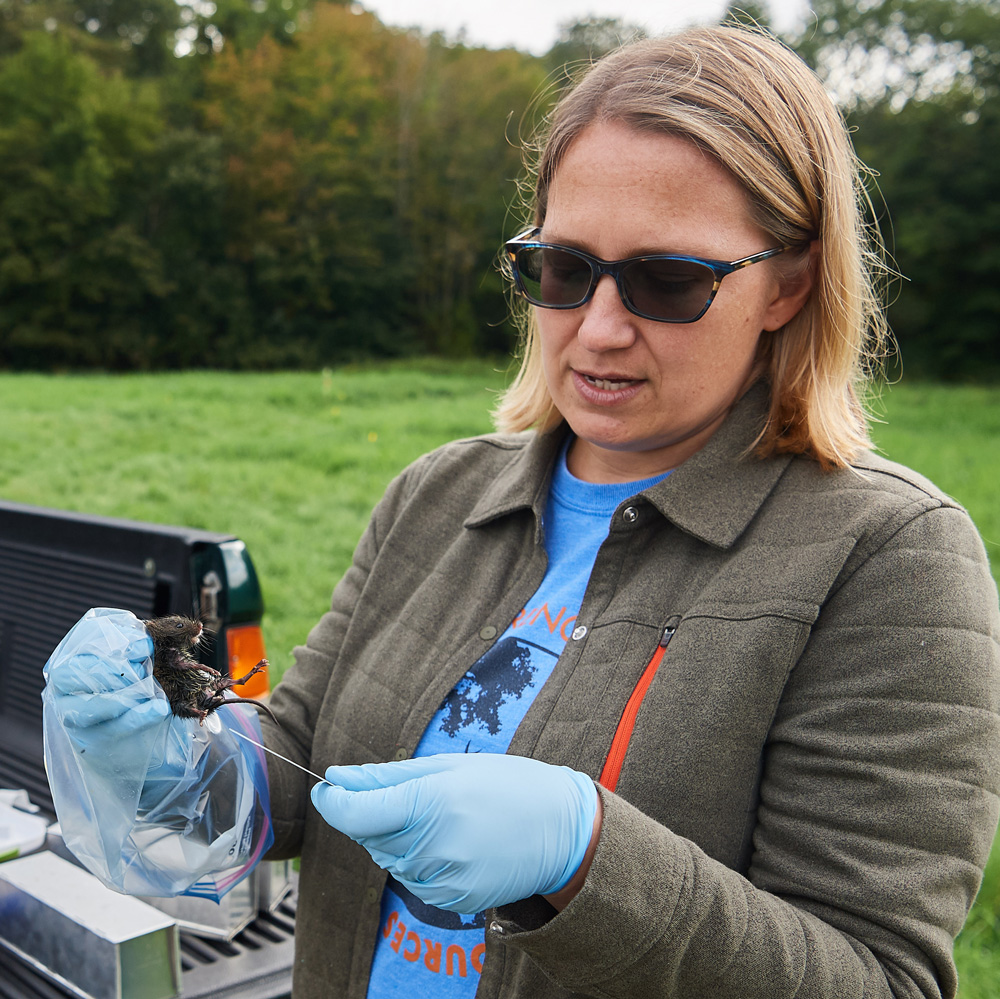
Rittenhouse, showing students how to measure the tail of a mouse, teaches wildlife techniques and researches wild populations. She knows, for instance, just how many bears and bobcats could be lurking in your Connecticut backyard.
“They’re just so quiet. People don’t see them even though they’re right there,” says Tracy Rittenhouse of the Connecticut bobcats she is studying. “I think they’re living in places more urban than we ever imagined.”
Her students have shown her pictures of a bobcat they spied in the parking lot of the Young Building on campus. “Bobcats are very good at avoiding people even though they’re active at all times of the day and night.”
Rittenhouse, associate professor of natural resources and the environment, was asked to help analyze data for The Bobcat Project that Connecticut’s Department of Energy and Environmental Protection (DEEP) began last year.
Despite having studied the state’s populations of everything from salamanders and bats to deer and bear, she finds this survey “super exciting.” Few in-depth studies have been done on bobcats anywhere in the country. So there’s a lot to learn.
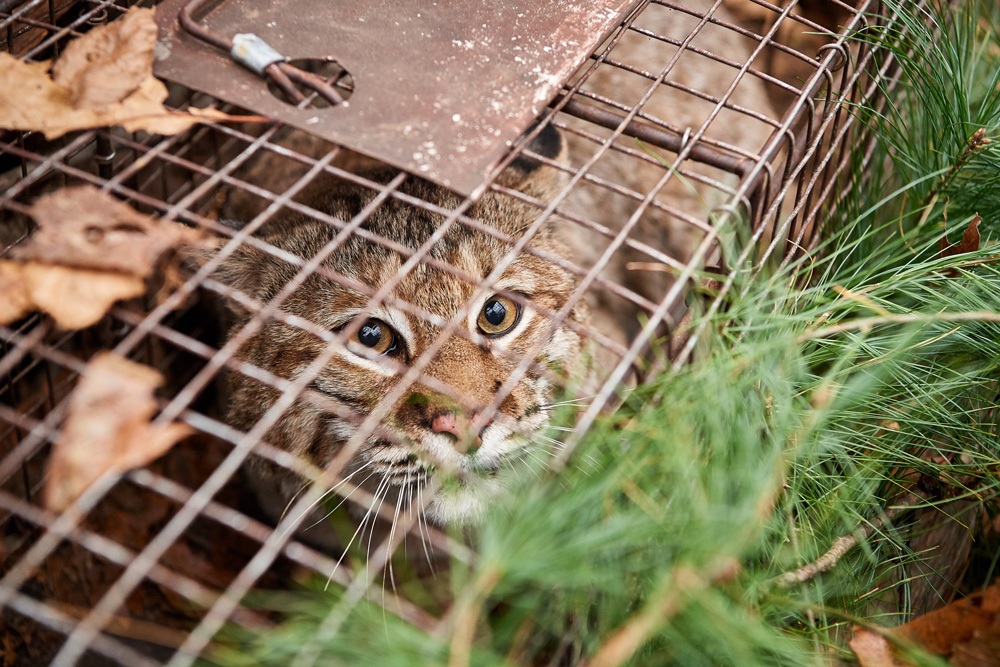
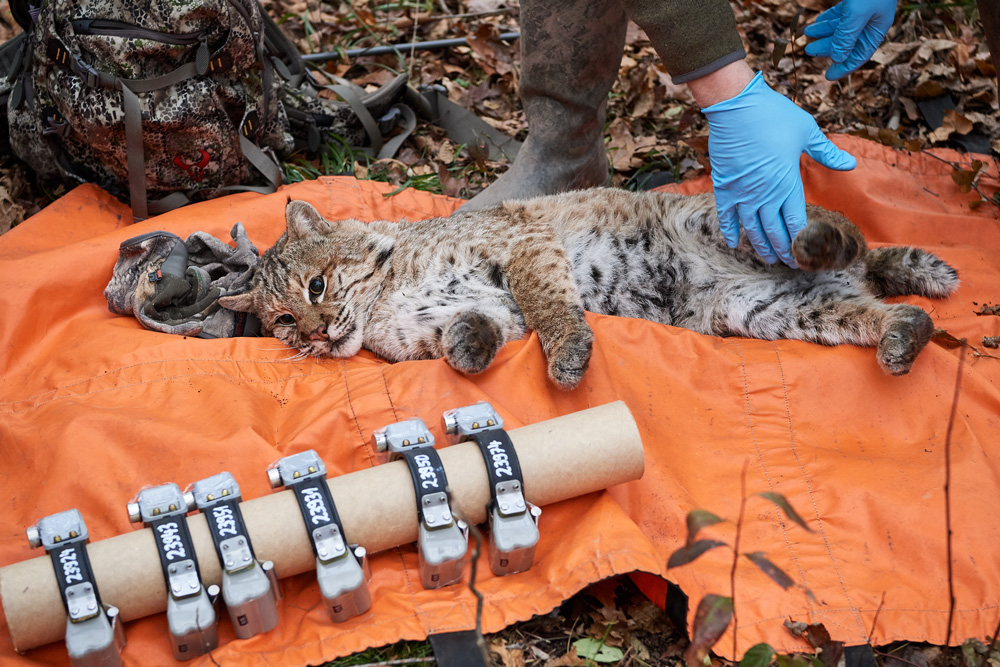
Rittenhouse works with DEEP biologists who are trapping bobcats, like this 35-pound male caught in the northeast corner in mid-November. Blood and hair samples are taken from the tranquilized cats who are fit with magnetic GPS collars that fall off after 300 days.
Q. What are you hoping the bobcat data you’re collecting will tell us?
A. It’s going to be really interesting to see how urban these cats go, what their movements are like, do their home ranges get bigger or smaller when they move into cities? And we’re doing some pilot radio isotope work on diet. We know they eat squirrels and rabbits and can eat deer. But do they also eat house cats or possibly turkey?
Q. DEEP tracked 50 cats last year and 30 so far this winter. What have you already learned?
A. They are more common than I thought. That’s my biggest take-home thus far. And I thought that we might be able to quantify when it gets too urban for them, and I think the answer is we don’t hit that here in Connecticut. I think the answer is they can be everywhere.
Q. People always say the deer aren’t in our roads; our roads are in their forests. I guess that’s true for bobcats, too?
A. That’s true in many places, but here in Connecticut we’re living in the exact opposite of that. In the 1800s, before we had laws to regulate it, people completely deforested Connecticut and much of the wildlife was extirpated. Turkey and bear were gone; deer and bobcat nearly gone. Then the landscape was developed. So we have this forest that’s grown up around houses and because this forest has regrown, the wildlife community has regrown with it. Bear and deer are examples of species that have increased.
I grew up in the suburbs in Minnesota and the neighborhood that I grew up in looks pretty similar to how it did when I was 5 years old, because it’s just the lawn and the trees that my dad planted. What we have here in Connecticut are parcels an acre or two in size, where we let trees grow up in parts of it and don’t mow the whole thing, so it’s really interesting to see what wildlife species benefit from that.
Q. What other Connecticut species have made a comeback?
A. I’m trying to figure that out. I’m really interested in looking at different taxa. I like working with amphibians; they make a nice contrast to mammals because what they need from their habitat is quite different.
“THEY ARE MORE COMMON THAN I THOUGHT. THAT’S MY BIGGEST TAKE-HOME THUS FAR.”
Q. If it’s not breaking into my garage, why should I care about this wildlife, where it is, and in what numbers?
A. Wildlife serve as an indicator of habitat quality: If it can support a salamander population, it’s a healthy stream. We’re in this exurban landscape here in Connecticut, this intermix of urban and forest. Having these healthy ecosystems gives us better air quality and better water quality and improves the spaces that we live in. And I think people like to look out their window and see trees and see flowing water. Your day is a little better when you get a bit of that, right?
Q. Growing up, did you bring forest creatures and strays home?
A. I was not that child. I think most people in wildlife are, but I was more of a suburbanite. I grew up in a two-kid-one-dog-two-car-garage house outside Minneapolis. Most of my day-to-day experiences were going to the playground across the street. I remember mallard ducks on the pond.
Q. So what did foster this career interest?
A. I watched the Discovery Channel — a lot. And my family took road trips every year to national parks. I got to see the big charismatic places and to appreciate how fortunate we are to live here because of the awe-inspiring places that our national parks really are.
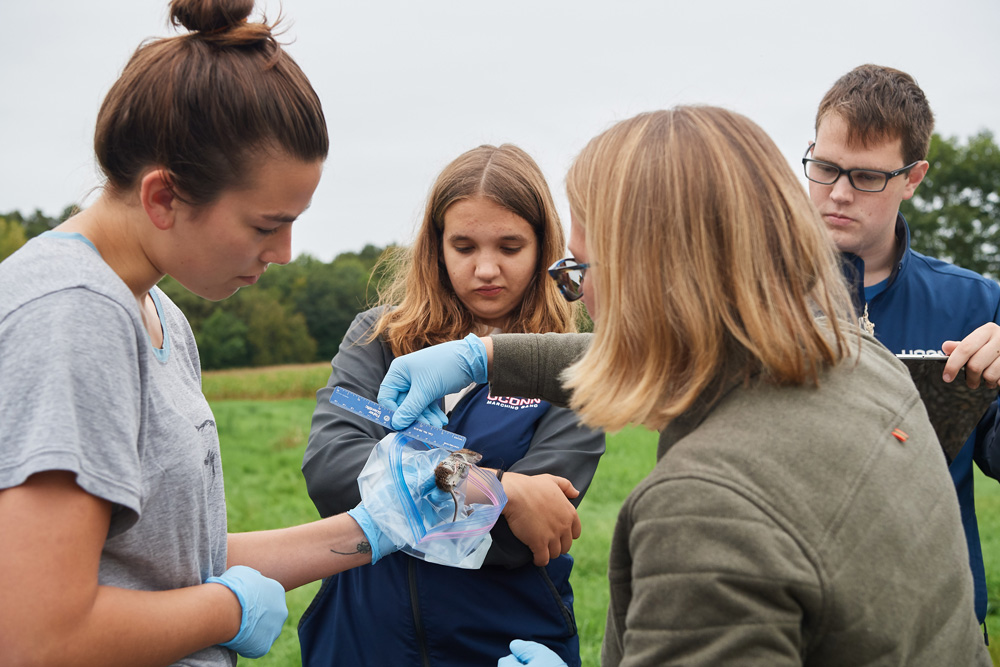
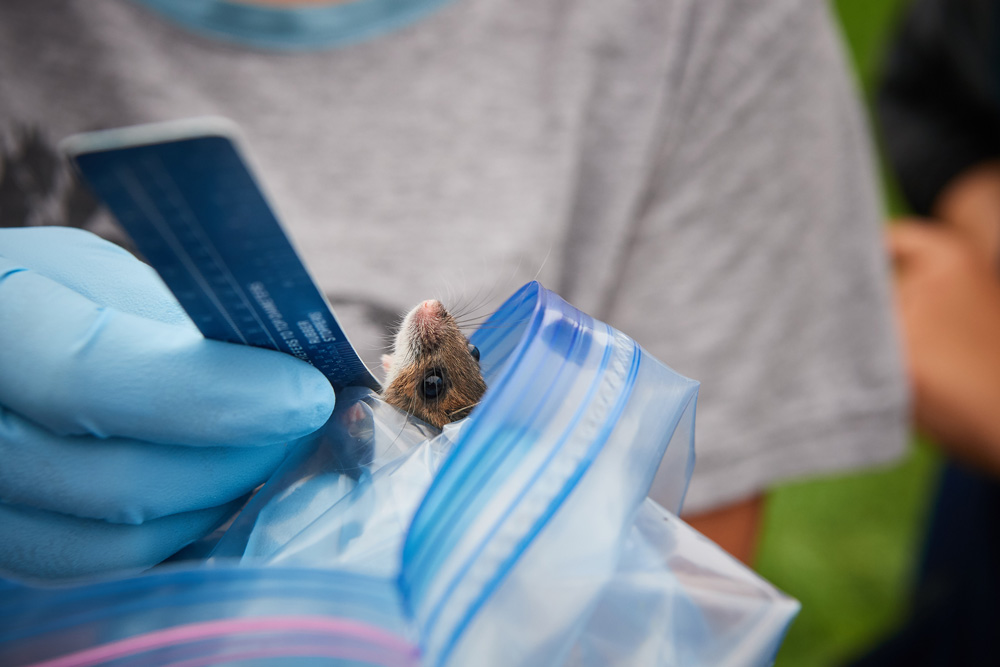
Students in Rittenhouse’s wildlife techniques class learn to trap, measure, sample, and release mice and voles in the fields and forest near Horsebarn Hill.
Q. What stands out from those trips?
A. I loved going to Glacier National Park and seeing the glaciers and the grizzly bears. My mom read “Night of the Grizzlies” out loud to us. Very scary book. [It recounts the true story of two separate fatal grizzly attacks at Glacier on one night in 1967.] We were camping in a tent trailer and my dad did not sleep at all.
I remember going to Yellowstone and being so excited and then being disappointed when I realized that there were human footprints everywhere. Before they had rules about staying on the path, people had had what I perceived as a negative influence on this beautiful place. And so I learned about how important it is to have managers, to have people who are making decisions about how to use the land.
Q. You attended undergrad at University of Wisconsin-Madison. How are your students here different than you and your peers were then?
A. We still thought we could protect all the species. These students are asking, How do we have forest that still has any wildlife populations in it? They think they are inheriting a planet that’s going to see a lot of change, and they’re going to be responsible for living in that change and managing that change, and they’re kind of bracing themselves for difficult decisions.
Q. That is so depressing.
A. [Laughs.] So one of the good things about studying population dynamics is seeing how resilient many wildlife populations are. Deer drop to very low numbers and become abundant again. And turkey. Raptors. So we know it’s possible for populations to rebound. There’s a natural capacity to survive. And that’s a good take-home from population dynamics. You don’t have to save every individual to save the population.
Q. Your children are 7 and 10. How are you passing an appreciation for nature on to them?
A. We try to go on a hike every weekend, even if it’s 20 minutes. We’ve gone to the Grand Canyon, Zion, and Bryce. No pop-up trailers, though. We cheat and hotel it.
And then there’s this — in a discussion about college I mentioned going to school in Milwaukee and Rittenhouse said she spent a summer there training to be a prima ballerina. So of course I asked:
Q: You could have been a prima ballerina?
A. I danced. I was reasonably good. I spent the summer between freshman and sophomore year of high school training with the Milwaukee Ballet. We took a class on everything you had to do to be a prima and one of the things was not to go to college. My reaction to that was: I’m going to go to college. I still danced all through high school, but I stopped living that dream that I was going to be the next big star.
Q: Did you dance in college?
A. No but I did think about majoring in voice.
Q. Wait, you sing too?
A. Yes. I didn’t pursue it, though. I had a choral director who said: You sing because you like to sing. To do it as a career, you have to be driven to sing.

I LIve in Niantic..Chapman Woods. THERE HAVE BEEN SEVERAL BOBCAT SIGHTINGS HERE…AS WELL AS THE NIGHTLY HOWLING. IS IT MATING SEASON?
Hi Carol,
We will get an answer from Tracy for you. Thanks for writing! — Lisa
Here’s what Tracy had to say:
Yes bobcat mating is late winter – about now.
We love when people post their photos and other sighting information to our iNaturalist page…
https://www.inaturalist.org/projects/ct-bobcat-project
Hi Tracy,
Love the work that you do-it is my passion in life as well, although not professionally. :-((( I serve on the Board of Directors of a nonprofit organization in Suffield, The Friends of the Farm at Hilltop(FOFAH), where my contribution is making the property more wildlife friendly and then teaching others how they can do the same in their yards. Would love to have you come visit some time. Just wanted to let you know that I have seen a bobcat in my yard twice in the past 2 years and on Sunday had the good fortune to see a beautiful one cross Route 75 ahead of me in the middle of the afternoon. We always have several visits from bears to our yard every year, which we enjoy-from the deck. Keep up the good work.
Hello,
My father in law lives in Orange about 1/4 mile from busy route 1 and he has had several sitings of either one bobcat or different ones. He has a couple of beautiful pictures of them. Ladt one he saw was about a week ago. Just thought that I would share.
I have three Bobcats that frequent my yard in Colchester. I think it’s a family unit. I have a seven minute video from trail cameras set up in the yard.
To see it use the search on YOUTUBE’s site and enter “zappp111” no capitals,no spaces, and click on “Bobcat Montage 2”.
They don’t follow a clear pattern, but are very active. My yard has condo’s, houses, some woods, and a hay field surrounding me.
It is interesting that many people commonly see bobcats in suburban areas. Between my property, a few other sizable ones and a very large land trust property we live on about a square mile of largely undeveloped land. I have seen bobcats twice in nearly 40 years and my wife has seen none. I haven’t seen a Fisher yet and my wife has seen one. We no longer see coyotes and their howling has dropped off from 4 or more episodes per night to a few weeks between single episodes and none so far this year, despite it being their mating season. We do see some deer, but they are very skittish. They sometimes come to our bird feeders, but only if they are left out overnight. Our more suburban friends report and photograph deer in their yards constantly. One friend in a small development regularly has deer at his bird feeders, sometimes as many as 14, whereas we are lucky to see more than 4 at one time as they sprint off into the woods. We do have lots of birds, but not the variety that more urban friends see. My wife saw a bear once and I have seen signs of bears twice. Has the wildlife adapted firmly to developed areas in CT? Or are they just closer to people and so seen more often? Just wondering.
Hello Tracy,
We live in Cheshire where we have been fortunate enough to see a lynx family recently and video them, a mother and young one. Our neighbor has also seen the lynx but with 2 young ones. We still have the video if it is of any value to your research.
Hi, Tracy.
We live on Codfish Falls Rd. in Storrs. Twice in the last week, we have seen a large bobcat walking on the ice on our pond behind our house.
Very beautiful. It seems much bigger than the one in your article. Too far away for a good photo, though.
Best to you.
Marylou
Hi Tracy,
Willington, CT
Yesterday 7/8/19 around 5:00 p.m. Saw a Bobcat in the yard. Very large. Around 60 lbs. Very healthy looking and have photos that I will send you. I Live on top of a hill 1/4 mile in the woods. A rare site for me. Beautiful animal.
Best,
Carol
Good Morning Tracy,
I am the program director for the Connecticut Christmas Tree Growers. We have 200 plus members. When you add it all up we have several thousand acres of farmland some forested and some quite open. We have many different animals roaming on the properties. We have deer, turkeys, coyotes, racoons even some bears. The deer can really do damage to our crops.
We are always looking for biological controls for the deer. We hoped that coyotes might provide some help there. They could do that especially on the young and old deer.
Reading the article in the UConn Magazine made me wonder if bobcats could provide some help in that area. I do not think anyone wants to bring back wolves.
We have over the years had speakers come and talk about deer, turkeys and bears. I am wondering if you would come and speak to our group about bobcats. I think everyone would be interested in their habits, their population growth, really anything you have learned about them. We have a curious bunch of people who want to know about what is going on on their property. With your knowledge and experience you can answer a lot of questions.
The date for our annual meeting is March 7, 2020. It is held at the Snow Elementary School in Middletown, Connecticut.
Please let me know. Thank you.
Will Jones
Jones Family Farms
Shelton, Connecticut